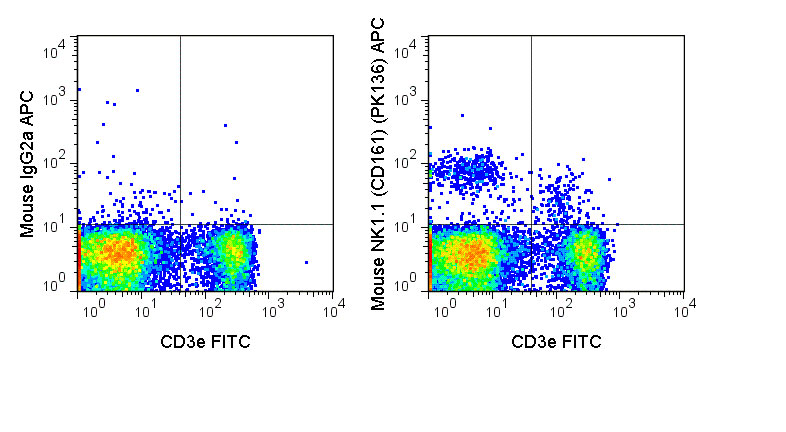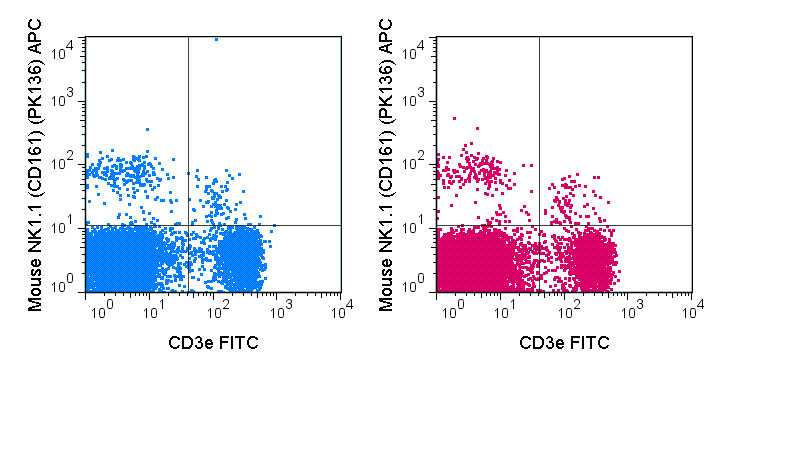APC Anti-Mouse NK1.1 (CD161) (PK136) Antibody
- SPECIFICATION
- CITATIONS
- PROTOCOLS
- BACKGROUND

Application
| FC |
|---|---|
| Isotype | Mouse IgG2a, kappa |
| Concentration | 0.2 mg/mL |
| Reactivity | Mouse |
| Formulation | 10 mM NaH2PO4, 150 mM NaCl, 0.09% NaN3, 0.1% gelatin, pH7.2 |
| Host | Mouse |
| Gene ID | 17059 |
|---|---|
| Gene Name | Klrb1c |
| Alternative Name(s) | CD161, NKR-P1C, Ly-55 |
| Format | APC |
| Preparation | This monoclonal antibody was purified from tissue culture supernatant via affinity chromatography. The purified antibody was conjugated under optimal conditions, with unreacted dye removed from the preparation. It is recommended to store the product undiluted at 4°C, and protected from prolonged exposure to light. Do not freeze. |
| Application Notes | This antibody preparation has been quality-tested for flow cytometry using mouse spleen cells, or an appropriate cell type (where indicated). The amount of antibody required for optimal staining of a cell sample should be determined empirically in your system. |
| Storage Conditions | 2-8°C protected from light |
Krebs DL, Chehal MK, Sio A, Huntington ND, Da ML, Ziltener P, Inglese M, Kountouri N, Priatel JJ, Jones J, Tarlinton DM, Anderson GP, Hibbs ML, and Harder KW. 2012. J. Immunol. 188:5094-5105. (in vivo depletion)
Lubinski JM, Lazear HM, Awasthi S, Wang F, and Friedman HM. 2011. J. Virol. 85(7): 3239-3249. (in vivo depletion)
Diamond MS, Kinder M, Matsushita H, Mashayekhi M, Dunn GP, Archambault JM, Lee H, Arthur CD, White JM, Kalinke U, Murphy KM, and Schreiber RD. 2011. J. Exp. Med. 208: 1989-2003. (in vivo depletion)
Awasthi A, Samarakoon A, Chu H, Kamalakannan R, Quilliam LA, Chrzanowska-Wodnicka M, White GC, and Malarkannan S. 2010. J. Exp. Med. 207: 1923-1938. (in vitro activation)
Coudert JD, Scarpellino L, Gros F, Vivier E, and Held W. 2008 Blood. 111: 3571-3578. (Immunoprecipitation)
Ljutic B, Carlyle JR, Filipp D, Nakagawa R, Julius M, and Zuniga-Pflucker JC. 2005. J. Immunol. 174: 4789-4796. (Immunoprecipitation)
Kanwar JR, Shen W-P, Kanwar RK, Berg RW, and Krissansen GW. 2001. J. Natl. Cancer Inst. 93: 1541-1552. (Immunohistochemistry – frozen tissue, Immunofluorescence microscopy – frozen tissue, in vivo depletion)
Provided below are standard protocols that you may find useful for product applications.
Background
The PK136 antibody is specific for mouse NK1.1, a type II transmembrane lectin-like receptor and member of the killer cell lectin-like receptor (KLR) family. NK1.1 is prominently expressed on natural killer (NK) cells, and is correlated with NK cytotoxic effects toward virus-infected cells and tumor cells. NK1.1 is expressed on subsets of NKT cells in certain mouse strains (C57BL/6, FVB/N, and NZB), yet absent from others (AKR, BALB/c, CBA/J, C3H, DBA/1, DBA/2, NOD, SJL, and 129). Putative subsets of NK cells and their expression of NK1.1 antigen are of continuing interest, including NK1.1+/CD117+ (c-Kit) cells reported to be immunosuppressive for CD8+ T cells in a mechanism involving PD-1 and PD-L1 (Ehlers et al. 2012. Endocrinology. 10: 1247).
The PK136 antibody may be used for detection of NK1.1 expression on mouse strains including CE, B6, NZB, C58, Ma/My, ST, SJL, and FVB. The antibody is reported to react with an epitope common to NKR-P1B and NKR-P1C alloantigenic forms of NK1.1 (Carlyle et al. 2006. J. Immunol. 176: 7511-7524).
If you have used an Abcepta product and would like to share how it has performed, please click on the "Submit Review" button and provide the requested information. Our staff will examine and post your review and contact you if needed.
If you have any additional inquiries please email technical services at tech@abcepta.com.














 Foundational characteristics of cancer include proliferation, angiogenesis, migration, evasion of apoptosis, and cellular immortality. Find key markers for these cellular processes and antibodies to detect them.
Foundational characteristics of cancer include proliferation, angiogenesis, migration, evasion of apoptosis, and cellular immortality. Find key markers for these cellular processes and antibodies to detect them. The SUMOplot™ Analysis Program predicts and scores sumoylation sites in your protein. SUMOylation is a post-translational modification involved in various cellular processes, such as nuclear-cytosolic transport, transcriptional regulation, apoptosis, protein stability, response to stress, and progression through the cell cycle.
The SUMOplot™ Analysis Program predicts and scores sumoylation sites in your protein. SUMOylation is a post-translational modification involved in various cellular processes, such as nuclear-cytosolic transport, transcriptional regulation, apoptosis, protein stability, response to stress, and progression through the cell cycle. The Autophagy Receptor Motif Plotter predicts and scores autophagy receptor binding sites in your protein. Identifying proteins connected to this pathway is critical to understanding the role of autophagy in physiological as well as pathological processes such as development, differentiation, neurodegenerative diseases, stress, infection, and cancer.
The Autophagy Receptor Motif Plotter predicts and scores autophagy receptor binding sites in your protein. Identifying proteins connected to this pathway is critical to understanding the role of autophagy in physiological as well as pathological processes such as development, differentiation, neurodegenerative diseases, stress, infection, and cancer.



